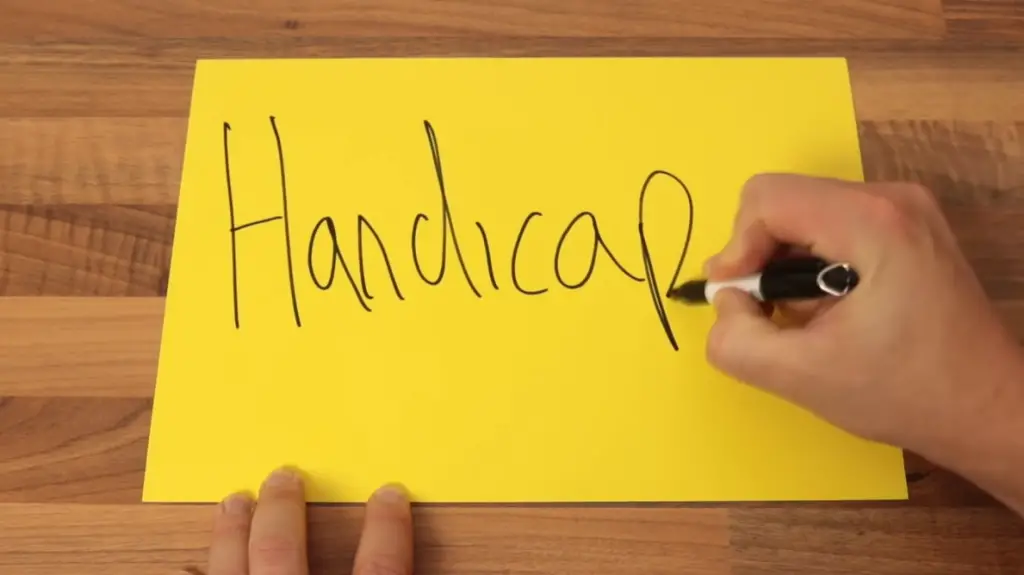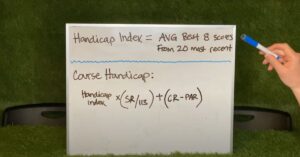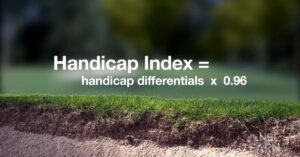What is a handicap in golf? Unlocking the Mystery of Handicaps
Golf is a sport that is enjoyed by people of all ages and skill levels, but for some players, the game can be a bit more challenging. This is where the concept of a “handicap” comes in.
A handicap is a numerical measure of a golfer’s potential ability and is used to level the playing field for players of different skill levels.
In this blog post, we will delve deeper into the world of golf handicaps, including what they are, how they are calculated, and how they are used in competitive play.

How to calculate golf handicap?
A handicap measures a golfer’s potential ability and is used to level the playing field when players of different abilities compete against each other. To calculate your handicap, you must:
- Play at least five rounds of golf on a course with a USGA-approved slope and rating.
- Keep track of your scores for each round, including any penalties and strokes taken.
- Submit your scorecards to a golf club or organization that maintains a handicap system, such as the USGA or R&A.
- The system will then calculate your handicap index, which measures your potential ability based on your recent scores.
- Your handicap can be converted to a course handicap, which is used to determine the number of strokes you receive on a specific course based on the slope and rating of the course.
- A handicap is a number that represents the number of strokes above or below par a golfer is likely to play, depending on the course and set of tees.
Please note that the process and calculation of handicaps may vary from country to country.
How to Improve Your Handicap?
To improve your handicap in golf, you should focus on several areas:

Practice regularly
Consistent practice is key to improving your golf game. Focus on different aspects of your game, such as your swing, short game, and putting.
Get professional help
Take lessons from a professional golf coach to identify and correct any flaws in your swing or other aspects of your game.
Play regularly
Playing in tournaments and other competitive settings can help you to improve your game and lower your handicap.
Analyze your game
Keep track of your shots. Fairways hit, greens in regulation, putts, and other statistics to identify areas of your game that need improvement.
Stay in shape
Golf is a physically demanding sport, so staying in good physical shape can help you to play better.
Mental and emotional control
Golf is also a mental game. Work on your emotional control, visualization, and mental preparation.
Equipment
Make sure you are using the right equipment for your game. A good set of clubs that properly fit your swing can make a big difference in your performance.
Handicap Systems in the United States

The United States Golf Association (USGA) Handicap System is one of the most widely used systems in the world.
It is a performance-based system that uses a player’s scores from different rounds of golf to calculate a handicap index.
This index is then used to adjust a player’s score for a specific course and set of tees, creating a more level playing field for players of different skill levels.
The USGA system uses a player’s best scores from their last 20 rounds of golf, with a maximum of 10 scores used from any one course.
These scores are then adjusted based on the course and tee played, and the resulting handicap index is used to create a “Course Handicap.”
This is the number of strokes a player receives based on their handicap index and the course and tee they are playing.
One of the key features of the USGA Handicap System is that it is constantly updated and recalculated.
Players must submit scores to their golf club or association, which then updates their handicap index.
This ensures that a player’s handicap accurately reflects their current skill level and abilities.
Handicap Systems in Europe
The Confederation of National Golf Unions (CONGU) Handicap System is used in the United Kingdom and Ireland.
It is similar to the USGA system in that it uses a player’s scores from different rounds of golf to calculate a handicap index.
However, it uses a different formula for calculating the index and has a few key differences in how scores are used and handicaps are adjusted.
CONGU system uses a player’s best 8 scores out of the last 20 rounds with a maximum of 4 scores from any one course.
It calculates the handicap index based on a player’s average score over the selected rounds, with adjustments made for the difficulty of the course and tees played.

The resulting handicap index is then used to create a “Playing Handicap,” which is the number of strokes a player receives on a specific course and set of tees.
The EGA Handicap System is used in most of Europe and is similar to the CONGU system. It also uses a player’s scores from different rounds of golf to calculate a handicap index.
The resulting index is used to create a “Playing Handicap,” which is the number of strokes a player receives on a specific course and set of tees.
EGA system uses a player’s best 8 scores out of the last 20 rounds with a maximum of 4 scores from any one course.
Handicap Systems in Asia
The Hong Kong Golf Association (HKGA) Handicap System is used in Hong Kong. It is a performance-based system that uses a player’s scores from different rounds of golf to calculate a handicap index.
The HKGA system uses a player’s best scores from their last 20 rounds of golf, with a maximum of 8 scores used from any one course.
These scores are then adjusted based on the course and tee played, and the resulting handicap index is used to create a “Course Handicap.”
The Japan Golf Association (JGA) Handicap System is used in Japan; it is similar to the USGA and CONGU system in that it uses a player’s scores from different rounds of golf to calculate a handicap index.
However, it uses a different formula for calculating the index and has a few key differences in how scores are used and handicaps are adjusted.
The JGA system uses a player’s best scores from their last 20 rounds of golf, with a maximum of 10 scores used from any one course.
Handicap Systems in Australia and New Zealand
The Australian Handicapping System is used in Australia and is a performance-based system that uses a player’s scores from different rounds of golf to calculate a handicap index.
The Australian system uses a player’s best scores from their last 20 rounds of golf, with a maximum of 8 scores used from any one course.
These scores are then adjusted based on the course and tee played, and the resulting handicap index is used to create a “Course Handicap.”
The New Zealand Handicapping System is used in New Zealand. It is similar to the Australian Handicapping system in that it uses a player’s scores from different rounds of golf to calculate a handicap index.
However, the New Zealand system uses a player’s best scores from their last 20 rounds, with a maximum of 10 scores used from any course.
These scores are then adjusted based on the course and tee played, and the resulting handicap index is used to create a “Course Handicap.”
Both systems are closely related and are generally considered to be more lenient than the systems used in the United States and Europe, allowing for more flexibility in how a player’s handicap is calculated and adjusted.
Final Words
In conclusion, a handicap in golf is a measure of a golfer’s potential ability, used to level the playing field for players of different skill levels.
It is calculated based on a golfer’s past performance and is expressed as a number of strokes.
A lower handicap indicates a more skilled golfer, while a higher handicap indicates a less skilled golfer.
Handicaps are used in tournament play and can also be used in friendly games to make the competition fairer.
Understanding and maintaining a handicap can help golfers of all skill levels enjoy the game and improve their performance.






